

MY COUNTRY: Land, People, Spirit. Odd - Grade 3/4 - First Contacts. First Contacts. Australia Day Sources (text version) First Australia Day painting Instructions Thinking about the painting and the letters and journals, what can an historian tell from the painting?
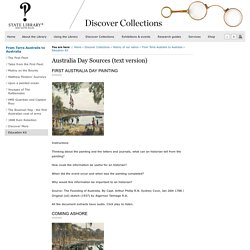
Illustration Of Convicts Standing In Disembarking Line At Sydney Cove Guarded By British Army Redcoats Stock Illustration. The British Army in Australia 1788 to 1870. Australia's military history began in 1788 when four companies of the Marine Corps arrived with the convicts in the First Fleet.
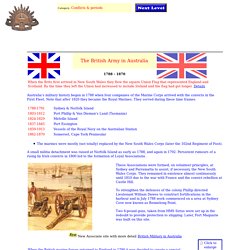
Note that after 1820 they became the Royal Marines. Old Sydney Town: Somersby: Rosetta Stabler's eating house. The British Invasion - British Colonisation Invasion. Aboriginal people and the colony of NSW - Australian History, Colonisation. Aboriginal people and the colony of NSW is an excerpt from the documentary Rites of Passage the second episode of the two-part series entitled Rogue Nation, produced in 2009.
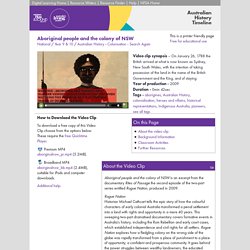
Rogue NationHistorian Michael Cathcart tells the epic story of how the colourful characters of early colonial Australia transformed a penal settlement into a land with rights and opportunity in a mere 40 years. This sweeping two-part dramatised documentary covers formative events in Australia’s history, including the Rum Rebellion and early court cases, which established independence and civil rights for all settlers. Aboriginal history timeline (1770 - 1899) <img src="/aboriginalculture/history/images/blue-mountains-echo-point.jpg" width="434" height="288" alt="Blue Mountains at Echo Point"/>Blue Mountains, New South Wales.

The Blue Mountains were long a barrier to the new colony’s expansion to the west. They are about 100 kilometres west of Sydney.1814 Governor Macquarie opens a school for Aboriginal children at Parramatta called the ‘Native Institution’ to “civilise, educate and foster habits of industry and decency in the Aborigines”. The local Aboriginal people (Koori) remove their children from the school after they realise that its aim is to distance the children from their families and communities.
Photos of Indigenous People and Places. Telling_Indigenous_stories_all_colour. Incidents between Aboriginal people in NSW and the British colonisers 1770-1792. Incidents between Aboriginal people in NSW and the British colonisers 1770-92 This is a chronology of significant events in cross-cultural relations between Indigenous and colonial settler societies.
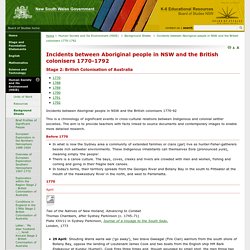
The aim is to provide teachers with facts linked to source documents and contemporary images to enable more detailed research. Before 1770 In what is now the Sydney area a community of extended families or clans (gal) live as hunter-fisher-gatherers beside rich saltwater environments. These Indigenous inhabitants call themselves Eora (pronounced yura), meaning simply ‘the people’. April Two of the Natives of New Holland, Advancing to Combat Thomas Chambers, after Sydney Parkinson (c. 1745–71) Plate XXV11 in Sydney Parkinson, Journal of a Voyage to the South Seas, London, 1773 May Many years later (about 1850), Sally Mettymong, aged about 80, points out Forby Sutherland’s grave at Kurnell.
January February 4 February: Eora resistance against the British begins. July August September October November. 1788 : Waruwi. Warning: This resource may contain references to Aboriginal and Torres Strait Islander people who may have passed away.
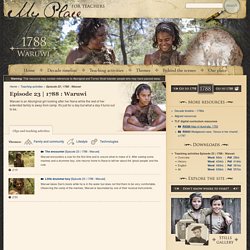
Waruwi is an Aboriginal girl looking after her Nana while the rest of her extended family is away from camp. It's just for a day but what a day it turns out to be. Governor Bligh arrives in NSW - Australian History, Colonisation. Governor Bligh arrives in NSW is an excerpt from the documentary Rites of Passage the second episode of the two-part series entitled Rogue Nation, produced in 2008.
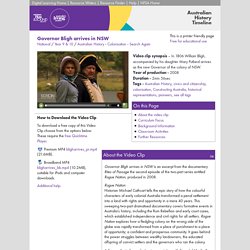
Rogue NationHistorian Michael Cathcart tells the epic story of how the colourful characters of early colonial Australia transformed a penal settlement into a land with rights and opportunity in a mere 40 years. This sweeping two-part dramatised documentary covers formative events in Australia’s history, including the Rum Rebellion and early court cases, which established independence and civil rights for all settlers. Transcript of Letter from Arthur Phillip. Growing up on Elizabeth Farm. The Macarthur children of Elizabeth Farm had fields, gardens and muddy riverbanks to explore.
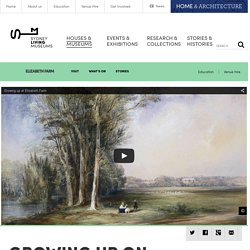
They had a large farm house to run around with cool verandahs, eerie cellars and curious nooks and crannies. Unlike most kids growing up in Sydney in the early 1800s, the Macarthur kids wore good clothes, ate fresh food, had servants at their beck and call and, best of all, an education. Elizabeth Farm is a classic single-story colonial farmhouse, huddled under a low shady roof, almost hidden inside a dense, rambling garden. Surrounded today by modern suburbia on the outskirts of busy Parramatta, the farm originally covered 600 acres of scrub, pastures, orchards and prime riverfront land. In this video Curator Scott Hill describes growing up at Elizabeth Farm and what made the Macarthurs different from their fellow colonial families. This video was originally produced by Sydney Living Museums as part of the exhibition Toys Through Time at the Museum of Sydney, 28 March 2015 - 9 August 2015.
A day in the life of a convict. Some hapless individuals experienced the full horrors of convict transportation.

It was no wonder that some, like Anderson, endured periods of mental instability. Navy seaman and thief Charles ‘Bony’ Anderson arrived in Sydney from Devonshire in 1834, aged 24. He was heavily tattooed, with designs of a mermaid, anchor, buoy, cottage, flag, heart, crucifix, sun, moon and seven stars, Adam and Eve, serpent and tree. In coming years he was frequently flogged, for mutinous conduct, striking fellow prisoners, assaulting an overseer and neglect of work. After one offence he was apparently cruelly chained to a rock on Goat Island, in public view and fed with a long pole.
Convicts and the British colonies in Australia. Augustus Earle (1793-1838), A government jail gang, Sydney, N S Wales, 1830.

Image courtesy of the National Library of Australia:nla.pic-an6065451. A penal colony On 18 January 1788 the First Fleet arrived at Botany Bay, which Joseph Banks had declared suitable for a penal colony after he returned from a journey there in 1770. Captain Arthur Phillip, the fleet's commander, brought a small party of marines and seamen ashore, but found the location unsuitable because the harbour was unsafe and the area lacked fresh water.
(The Oxford Companion to Australian History). Convicts To Australia ... Some Tales. The convict. A convict story with 'O' in convict as broad arrow - Convict identities. First Australians – Episode 1, They Have Come to Stay (2008) clip 2 on ASO. Clip description On 25 January 1788 the First Fleet enters Sydney Harbour. Narrator Rachel Perkins and historian Professor Marcia Langton of the Yiman-Bidjara Nation convey the Indigenous point of view of this event. First Australians – Episode 1, They Have Come to Stay (2008) clip 1 on ASO. Clip description. First Fleet: 04/02/2014, Behind the News. Recently we celebrated Australia day on the 26th of January. But why do we mark it on that day in particular? To answer that question, Sarah will take you back in time to 1788, to meet some kids who came to Australia on the First Fleet.
Kid 1: “My name is John Hudson and I'm nine years old. I've been an orphan ever since I can remember and I made a living sweeping chimneys. First Fleet - Stories. Convicts Transported to Australia: A Guide to Researching Your Convict Ancestors. Farm lad. Convicts To Australia ... The Ultimate Convict Quiz. My Place: 1780s. In 1787 Lord Sydney (1733–1800) of the British Colonial Office in Great Britain gave instructions to Governor Arthur Phillip (1738–1814) to establish a penal colony on the Dutch-named land, New Holland.
He was also ordered to open friendly communications with the local Indigenous peoples and encourage the convicts and marines to show them kindness. His instructions required giving protection to Indigenous people and punishing those who harmed them. There is no evidence of any acknowledgement of Indigenous peoples' ownership of the land. What's Australia Day all about? 00:00:00:00On-screen text reads, 'Viewer advice - Aboriginal and Torres Strait Islander viewers are advised that the following media resource may contain images and voices of people who have died.'00:00:05:20Reporter Andrea Nicolas, from ABC's Behind The News, narrates.00:00:08:03ANDREA NICOLAS:January 26th - it sounds like an important date. ABC Splash: Convict & Colonial Australia.